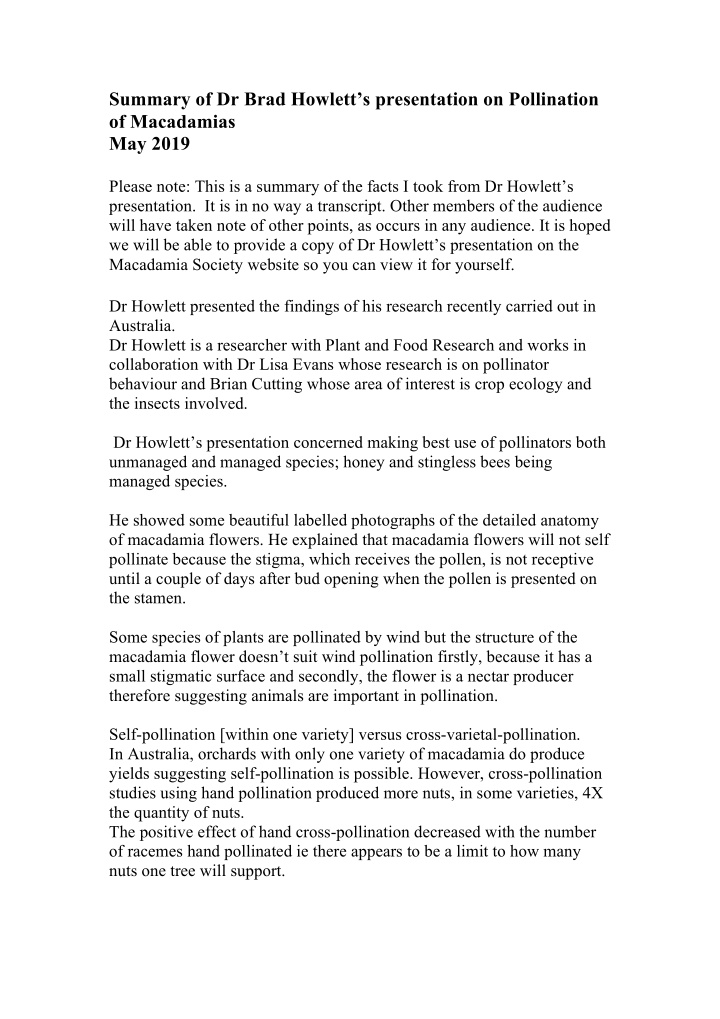



Summary of Dr Brad Howlett’s presentation on Pollination of Macadamias May 2019 Please note: This is a summary of the facts I took from Dr Howlett’s presentation. It is in no way a transcript. Other members of the audience will have taken note of other points, as occurs in any audience. It is hoped we will be able to provide a copy of Dr Howlett’s presentation on the Macadamia Society website so you can view it for yourself. Dr Howlett presented the findings of his research recently carried out in Australia. Dr Howlett is a researcher with Plant and Food Research and works in collaboration with Dr Lisa Evans whose research is on pollinator behaviour and Brian Cutting whose area of interest is crop ecology and the insects involved. Dr Howlett’s presentation concerned making best use of pollinators both unmanaged and managed species; honey and stingless bees being managed species. He showed some beautiful labelled photographs of the detailed anatomy of macadamia flowers. He explained that macadamia flowers will not self pollinate because the stigma, which receives the pollen, is not receptive until a couple of days after bud opening when the pollen is presented on the stamen. Some species of plants are pollinated by wind but the structure of the macadamia flower doesn’t suit wind pollination firstly, because it has a small stigmatic surface and secondly, the flower is a nectar producer therefore suggesting animals are important in pollination. Self-pollination [within one variety] versus cross-varietal-pollination. In Australia, orchards with only one variety of macadamia do produce yields suggesting self-pollination is possible. However, cross-pollination studies using hand pollination produced more nuts, in some varieties, 4X the quantity of nuts. The positive effect of hand cross-pollination decreased with the number of racemes hand pollinated ie there appears to be a limit to how many nuts one tree will support.
How do you get better pollination? In Australia and in some NZ orchards, growers are using managed insect species such as honeybees and stingless bees. Other possible pollinators are moths, butterflies, birds, flies and beetles Studies have clearly shown that pollinator diversity is important in a whole range of crops worldwide. Some insects are more efficient pollinators than others for a number of reasons. For example, the shape and behaviour of the insect must ensure optimal placement of the pollen on the stigma and will determine whether self or cross-pollination occurs. Honeybees for example tend to visit multiple flowers on the same tree therefore resulting in self rather than cross- pollination. Pollinator movement and abundance is important and which pollinators are at work depends on the time of day and the weather, honeybees work in the sun and bumblebees work on cloudy days. Abundance studies of pollinators in Australia suggest 77% honeybees [ when hives are introduced for flowering] and 25% other species not introduced. Placement of Pollen. Which insect is best? Honeybees are nectar feeders and therefore are working at the base of the flower away from the stigma. In Australia only 2% of visits by a honey bee put pollen on the stigma whereas Lycid and Soldier beetles were much more effective at contacting the stigma. In NZ we have no research but hoverflies, bumblebees, blowflies and butterflies may be playing a key role. How do we encourage pollinator species? Refer to the website https://beeaware.org.au for information on ensuring safety for bees and other pollinators in your orchard. Plant multiple cultivars to ensure maximum pollination and planting patterns of varieties may be important. Work with your beekeeper to protect his/ her bees and maximise your crop. Placement of hives within the orchard could be important. Don’t bunch the hives all in one spot. Pollination agreements are recommended [as in the kiwifruit industry], without agreements you may end up with the weak hives. Prune with thought of pollination as bees work in the light. Pruning windows will allow light in towards the centre of the tree
Pesticides can kill all insects. See https://beeaware.org.au Promote diversity of pollinators by planting other plant species. It is important to know that the species of plants you use do not host a pest species, [see GM presentation]. Provide floral resources, i.e. plants that flower at times when the macadamias are not flowering as it will keep the non managed pollinators such as native bees and drone flies in your orchard. These may be the most efficient pollinators anyway. Summary by Donna Hardie Outgoing Secretary
Recommend
More recommend